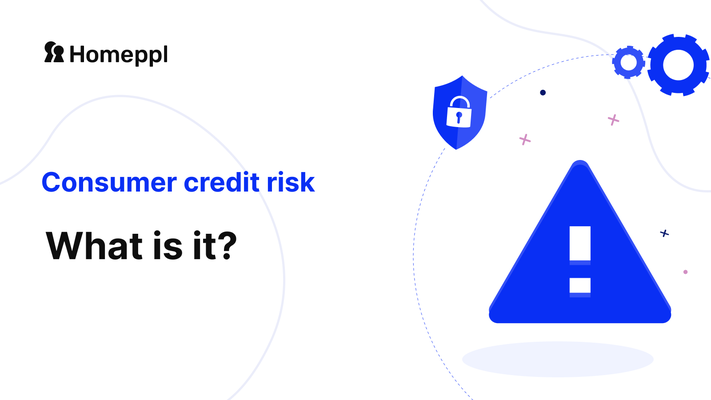Consumer credit risk refers to the possibility of a loss due to a borrower’s inability to repay a debt in accordance with the lender's agreed terms. Consumer credit products are extended to individuals rather than business and include mortgages, personal loans, credit cards, rental agreements and additional forms of borrowing. Consumer defaults typically result in a loss of principal and interest for the lender, disrupting cash flows and incurring additional costs for collection.
What is consumer credit risk assessment and why is it important?
Consumer credit risk assessment is a standardised method undertaken by lenders to evaluate a prospective borrower's creditworthiness and affordability in order to determine how capable they are of repaying principal and interest obligations. Further, it enables lenders to understand the level of risk posed by a customer in order to implement the required level of verification and subsequent loan terms to mitigate potential losses. The value of risk assessments does not only apply to loan lenders but extends to any business that intends to enter a long-term financial agreement with a customer, this includes landlord and letting agency rental services, car leasing companies or even buy now and pay later services.
How does consumer credit analysis determine creditworthiness?
An Individual's credit risk is determined with consideration of numerous factors, such as the borrower’s credit history, current income status, employment stability, debt-to-income ratio, and any additional financial obligations they may have. Interest rate charges are often influenced by an consumers credit risk, as high-risk borrowers are often subjected to higher rates to compensate for the increased risk as a means to protect against losses should the individual default.
For financial organisations, consumer credit analysis is an integral component of the lending process. While it is hard to predict which customers may fail on their obligations, appropriate credit risk assessment and management can lessen the severity of a loss.

What consumer credit risk assessment methods can be used?
Lenders leverage various credit assessment methods to establish a consumer's creditworthiness, including credit scoring models, loan application reviews and underwriting processes. The majority of lenders utilize the five C’s when assessing creditworthiness;
Credit History - asses previous loans and repayments
Capacity - asses a customer's ability to repay loans
Capital - asses how much money a cutomer has access to
Collateral - takes into account a customer's current assests
Conditions - refers to understanding the purpose of the loan
Consumer credit risk models via machine learning algorithms
Consumer credit risk models are statistical algorithms used to evaluate the creditworthiness of individuals based on their financial history and behaviour. These models analyse a variety of data points including credit history, income, debt, and payment patterns to determine a customer's credit score. The volume of decisions involved in the consumer lending business calls for reliable models and algorithms rather than human judgment. Algorithmic decisions need to be based on hard information such as data derived from consumer credit files. A variety of lending institutions and credit bureaus rely on custom-made risk models based on privately collected information based on customers' past behaviour. While such models are generally capable of producing adequate risk assessment measures, they remain indifferent to changes in market conditions.
Machine learning algorithms can be utilised to develop more effective consumer credit risk models due to their ability to handle large amounts of data and identify complex patterns that may often be overlooked using traditional statistical methods.
Credit risk decisioning software
Many, if not all, lenders and financial institutions will consult credit reference agencies at the point a consumer wishes to apply for a new financial product.
That data, whilst evidently useful, is also limited. It provides a history on the credit agreements taken out in a consumer's name: anything purchased on finance, utility and phone bills, any credit products already taken out and the rate at which a consumer pays any money and interest owed back to the financial supplier.
Credit bureau data is limited when it comes to people newly taking out credit in the UK and struggle to really assess internationals, expats, students, the 'thin-filed' as well as the self-employed and high net-worth individuals due to the complex nature of their income streams.
Credit risk assessment software is available to offer lenders an additional layer of personal and banking data to make even better informed decisions. For instance, see:
The video above is of Homeppl's Fraud Finder tool.
It's a risk qualification tool which finds document fraud in financial documents such as bank statements, payslips and utility bills. Additionally, it turns financial documents into JSON code. The banking data extracted from these documents are then analysed and presented as more insightful data patterns to better gauge a consumer's true credit risk, straight from their own personal financial behaviour.
On top of the data offered by credit agencies, this tool can signal:
Multiple sources of income and overall financial stability
Spending patterns for necessary household expenses like rent or mortgage payments
Purchasing behaviour and associated credit risk
Outstanding short-term, high-interest debt, such as payday loans, or monthly repayments for BNPL products
Gambling habits if applicable
Debt repayment transactions and practices
Whilst this extra data can ensure that lenders and banks are providing credit on more precise data, it picks up on the assessment of those profiles where credit references agencies are limited in their analyses.
In conclusion, consumer credit risk assessment is a critical tool used by lenders to evaluate the creditworthiness of potential borrowers and determine the level of risk they pose. By considering various factors, such as credit history, income status, and debt-to-income ratio, lenders can assess a borrower's ability to repay the loan and decide on appropriate loan terms. The use of credit scoring models, loan application reviews, underwriting processes, and machine learning algorithms can aid in developing effective consumer credit risk models that can handle large amounts of data and identify complex patterns. Additionally, credit risk decisioning software can provide lenders with an extra layer of personal and banking data to make even more informed decisions. Ultimately, appropriate credit risk assessment and management can help lessen the severity of potential losses and ensure responsible lending practices.
What to read next:




